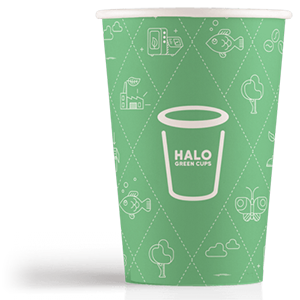
The Dutch love a cup of coffee from time to time, especially during a lunch break at work. Cardboard coffee cups are increasingly becoming the standard and are also better than the plastic disposable variety. But things can still be done in a much more sustainable way. Six years ago Goedkopekoffiebekers.nl. from Baflo started a new production line for compostable coffee cups. During the processing, the energy from the cups is recovered in the form of biogas. Operational director Tjeert Staal explained to Innovation Origins how this works.
What does that compostable cup look like?
“A disposable coffee cup is made of cardboard for about 95 per cent and also has a coating. ‘Normal’ coffee cups have a PE coating. This is a plastic protective layer that ensures that liquids cannot leak through the plastic. Our Halo Green Cups on the other hand have a PLA coating, based on vegetal raw materials. This means that our entire coffee cup is industrially compostable.”
How are the used cups processed?
“Our customers remove the cups from the boxes and place them next to the coffee machine in the office. The used cups are then returned to us in the same box that they came in. This box contains a mesh and an anti-leakage bag, again based on a PLA coating. We then pick up the boxes again. Please bear in mind that the customer must return the coffee cups to the box as clean as possible, so that they can be processed properly. We have an agreement with our customers for a maximum contamination level of 3%. We check this visually when we come to pick up the cups.”
“After that, the cups are sent to the waste processing company Attero. There, they are first put through a shredder and then fermented using an anaerobic, low-oxygen process in which bacteria do their work. The fermentation process releases biogas, which is collected and pumped back into the gas network. This greatly reduces the amount of CO₂ emissions. What is left over is fertile compost. We offer this to garden centres.

Why are compostable cups better than regular cardboard cups?
“Regular cardboard cups are thrown away with general waste. They are taken to a waste processor that separates the PE coating from the cardboard. The cardboard is then used as a raw material for, among other things, hygienic paper. In principle, it is a good thing that the cups can still be recycled like this and are given a second life. You stimulate a circular economy this way. However, the great advantage of fermenting our cups with the PLA coating is that it leads to a substantial reduction in CO₂ emissions.”
Is there a great demand in society for sustainable cups?
“Most definitely. Especially when it comes to coffee cups that are used in the workplace. People often drink a cup of coffee at the office and they tend to see cups all around them throughout the day. And then they think: ‘What a shame, that they are just going to be thrown away.’ Obviously, it’s great that they realize this. But other packaging, such as drinks cartons, also need to be made more sustainable. The volumes of waste are also much larger, which means that you can make a greater impact by switching to green production.”
Are there any other plans in the works to become more sustainable?
“We are exploring whether it is possible to produce completely plastic-free cups. Here, the water-based protective coating is made of a different material, the composition of which we are not going to disclose yet. We are in the middle of the certification process and are researching the extent to which these cups are really plastic-free. It would, of course, be ideal if our society were to become completely independent of plastics. You can see that the world is moving in that direction. Just look at the increasingly stricter European regulations on disposable plastics. As a manufacturer, we certainly want to be at the forefront of this.”


